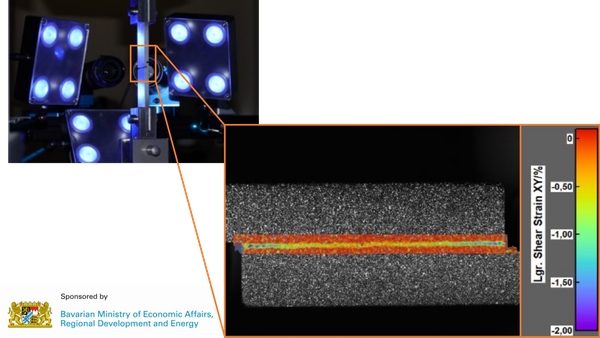Tensile shear tests of bonded joints using digital image correlation

Sandwich structures offer very high lightweight design potential due to their very high specific stiffness and are therefore used in many aerospace structures. A key challenge in the design of sandwich components is the load transfer of local forces that occur at the joints to the sandwich. The sandwich core, which is usually very soft, and the thin cover skins can only absorb local loads to a very limited extent. Therefore, so-called inserts are used in the load introduction areas, usually simple load introduction structures such as sleeves or bushings that are inserted into the sandwich structure. In application, sandwich components have a large number of connection points, which is why there is a high potential for weight reduction here.
In the BLANCA project, new load introduction structures are being developed using additive manufacturing and optimized structural bonding, which are optimized in terms of the weight and effectiveness of the load introductions. Furthermore, through the further development of virtual and physical testing, the structural verification of corresponding aerospace structures will be made more efficient and robust and, as far as possible, virtualized using validated and verified simulation models. To this end, analytical and numerical methods for modeling and simulating material and structural behavior under structural load are being developed and validated via a sample and test program. In addition to reducing costs in the course of component development, this also succeeds in saving valuable resources, since a smaller number of physical tests are necessary as part of the validation.
Derivation of criteria for component development
Structural bonding
Additively manufactured load introduction
Sandwich component
Assembly
From a scientific point of view, the investigations in the BLANCA project contribute to a better material and structural understanding of load introduction in sandwich structures. By developing and applying new simulation and load introduction concepts, optimized load introduction elements could be designed. The structural behavior was optimized for both static and dynamic loads. In addition, a more reliable application of virtual calculation models was achieved through the extensive test series.
The methods and concepts developed can be applied in future studies for more complex assemblies as well as for other materials. This could help to further deepen the knowledge gained in the project. Further research would also be conceivable in the area of alternative core materials and associated load introduction design. Further research activities would also be interesting with regard to increased functional integration in sandwich components.
Our research project BLANCA is based on the funding initiative BayLu25. The funding program is mainly concerned with research, development and innovation projects basically in the field of action "Increasing productivity and material efficiency in the aviation industry".
Project duration: January 2021 to December 2023
Funding volume for the University of the German Armed Forces: 288,400€.
The project is funded by the Bavarian State Ministry of Economic Affairs, Regional Development and Energy.